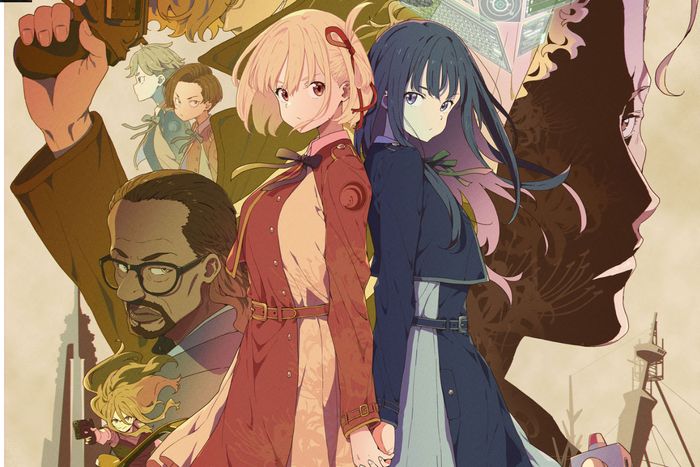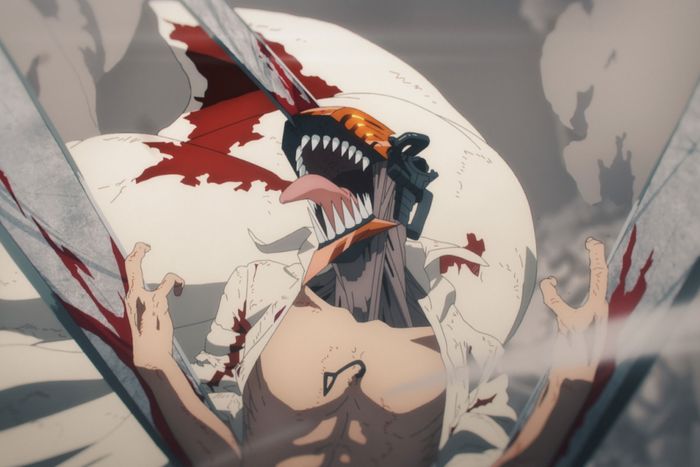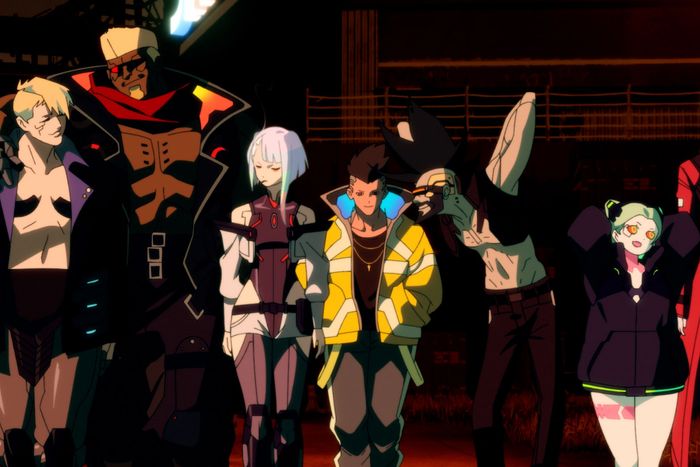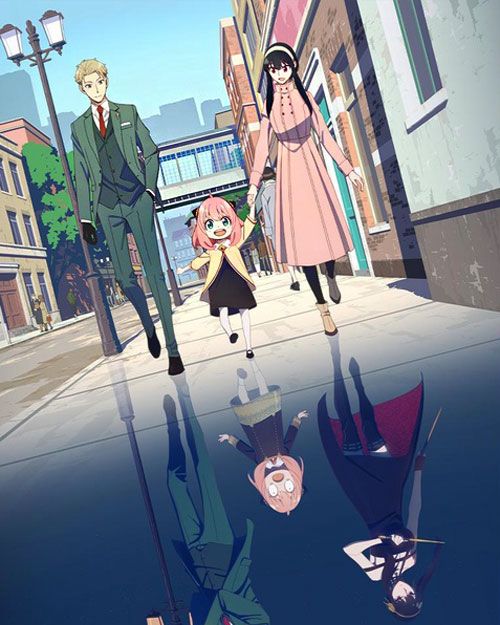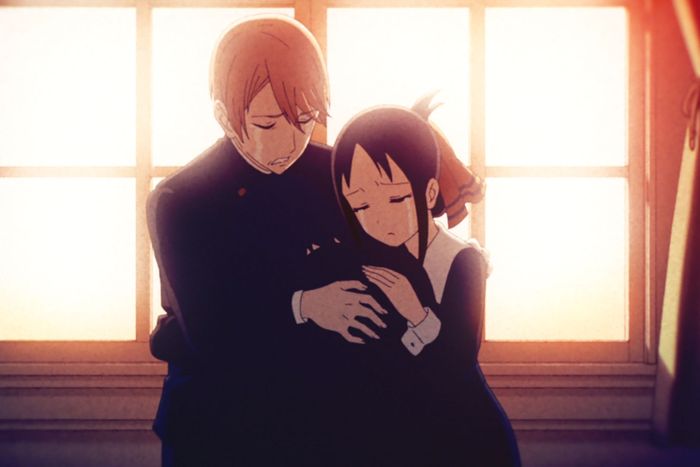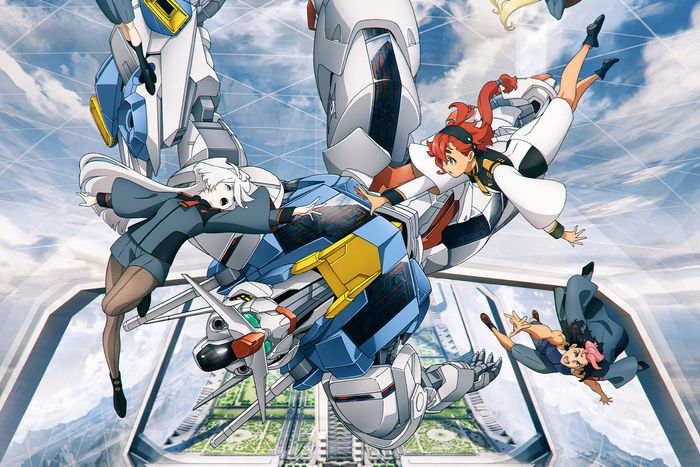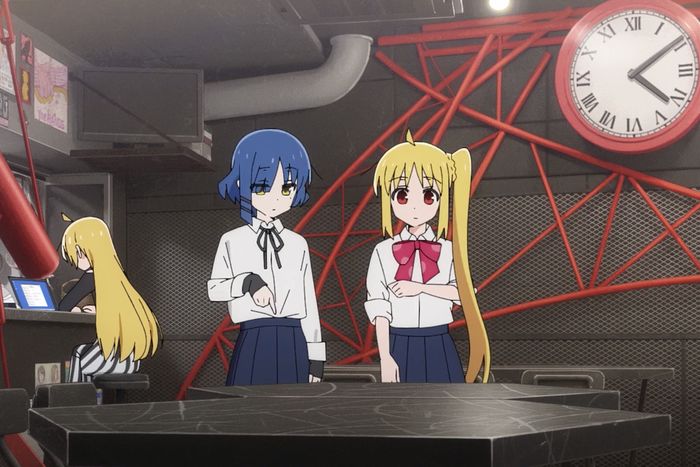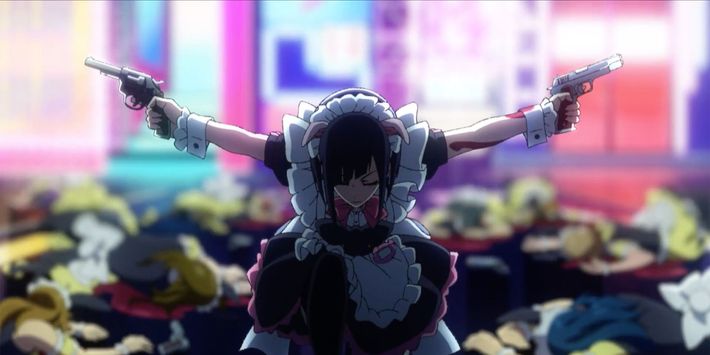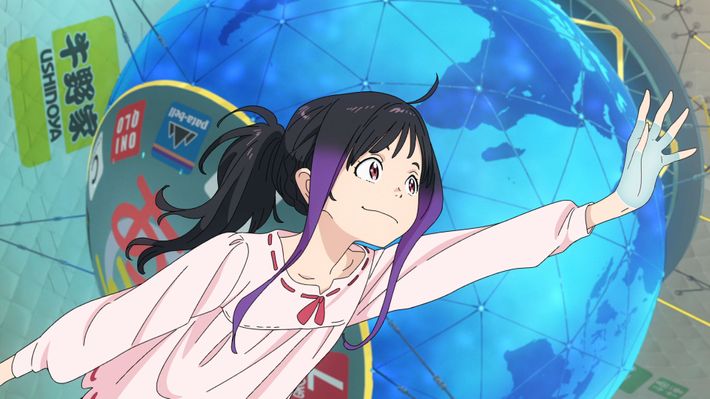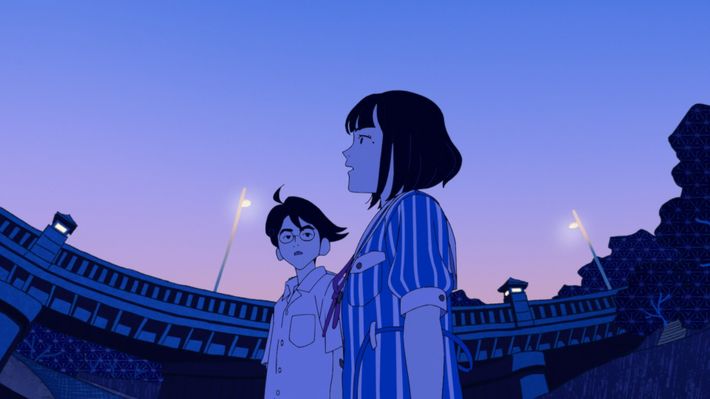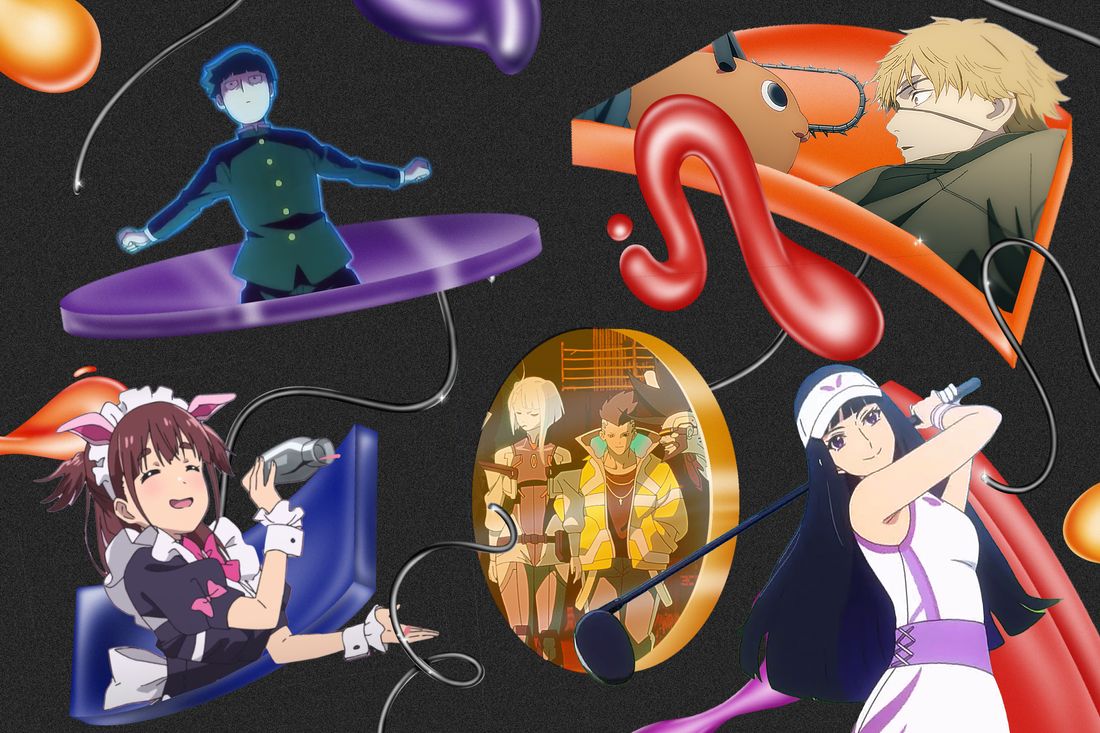
In just the past couple of months alone, 2022 has been abnormally packed for anime on TV with dozens of hotly anticipated originals, adaptations, and returning favorites all dovetailing with one another. Listing the ten best anime TV series this year — including the bombastic action of Chainsaw Man, the romantic comedy of Kaguya-sama, and the healing drama of Do It Yourself! — required some painful cuts that in any other year could certainly have ranked. It’s almost strange to think that a sci-fi odyssey like The Orbital Children or the infectious offbeat oddity Akiba Maid War, among others, made only the honorable mentions, but the entries we’ve detailed below are just that creatively daring and visually exciting. These are the best anime shows of the year, ranging from the thrilling to the heartwarming and the downright weird.
10.
Lycoris Recoil
A springtime standout (with loud support from Hideo Kojima), the girls-with-guns action anime original Lycoris Recoil, from director Shingo Adachi and writer Asaura, offers a delightful contrast of silly, easygoing slice-of-life moments and impactful violence as it follows main characters who help run a café while handling mercenary contracts on the side. In the first episode, the taciturn Takina is demoted from a secret organization of all-girl assassins — named Lycoris, after the spider lily — who secretly kill criminals to maintain an “age of peace.” She’s sent to LycoReco Café, a front for another branch of the agency. There she meets Chisato, a fellow lethal teenager whose sunny demeanor is the opposite of Takina’s aloofness, and their buddy action-comedy rapport (with strong romantic undertones) kicks off.
The first twist in that formula is that Chisato has given up killing, though that doesn’t mean she won’t cause bodily harm when called upon, now using rubber bullets alongside her practically supernatural, very entertaining ability to dodge gunfire. Chisato’s fighting tests the suspension of disbelief throughout, but there’s a credible weight to the action even as she evades bullets with ease. The fights are excellent, and both its real and mock battles of gunplay and hand-to-hand combat are fun to watch simply because of how untouchable the pair is, until the show’s broader conspiracy plot complicates things for them. Even as it shifts to a longer-form story, Lycoris Recoil never sacrifices its moment-to-moment, episode-to-episode accessibility, and its characters are as charming as they are deadly.
9.
Do It Yourself!
Few shows this year feel as warmly pleasant as Do It Yourself!, an anime about hobbyists that has a slightly absurd edge. The main character has a pet pig that wears sunglasses, and there are endearing puns, starting with the protagonist being called Yua Serufu (“yourself”), which should tell you what kind of show this is. Serufu is childhood friends with Miku “Purin” Suride, but their friendship splinters when they attend different high schools: Miku goes to a prestigious vocational school run on the cutting-edge tech of the show’s setting in the “Fourth Industrial Revolution.” Serufu heads to a more traditional girls’ school where happenstance leads her to its increasingly obsolete DIY club. There she embarks on personal projects with a gradually expanding group of eccentric, adroit kids.
This is all presented inside Do It Yourself’s sleepily comedic framework, but the show feels like a joyous counterpoint to our own tech-dominated present day. It’s about simple pleasures, making things with your hands, and, yes, doing things yourself. It portrays this joy with a wonderfully cozy art style. The striking character designs are drawn without shadows and have loose, delicate linework, while the tools and the crafts they’re used for are rendered with realistic detail and precise timing. Alongside the beautifully faded backgrounds and soft colors (one of my favorite touches: Each character’s hair has a different tint under the main shade), it all combines for a pleasant, tactile visual experience that matches the narrative thesis of the show.
8.
Chainsaw Man
Chainsaw Man, adapted from the excellent manga by Tatsuki Fujimoto, is handily the highest-profile release of the year — so big even the U.S. Consumer Product Safety Commission took notice. It’s set in a world where monsters called Devils represent everything from the Four Horsemen of the Apocalypse to mundane items, like a tomato. They’re common enough that society needs Devil Hunters, who wear simple (but slick) suit-and-tie uniforms as they kill their prey. Enter Denji: an impoverished teenager whose only option is to become a hunter. After being betrayed and left for dead, Denji is revived as Chainsaw Man, a combination of man and devil. He’s recruited into the workforce — and things only go off the rails from there.
Series director Ryu Nakamura delivers a sumptuous, surprisingly patient take on the manga, compared with Fujimoto’s fast-paced experimentalism with comic-book language. The show’s framing is measured, cold, and realistic and its comedy a little more deadpan, injecting each chapter with intimate drama and quiet physical acting for the animated characters. The results work wonders. Certain deaths hit harder because of those extra little moments of humanization. There are glimmers of the manga’s tone and symbolism, too, in Kensuke Ushio’s propulsive, off-kilter score, the cinephilic opening, and the ever-changing end credits for each episode. Even with the wild twists and ruthless brutality already on display, the story is still in its early stages, and the adaptation has already spared no expense in finessing the series’ growing pains with its craziest moments just around the corner. That potential makes Chainsaw Man even more exciting.
7.
Cyberpunk: Edgerunners
Cyberpunk: Edgerunners may be one of the most effective marketing stunts of the decade. Amid hundreds of other animated video-game tie-ins — take last year’s excellent Arcane or the glut of other Netflix commissions including Tekken: Bloodline and Castlevania — the show, created by Rafal Jaki and directed by Hiroyuki Imaishi (best known for the series Tengen Toppa Gurren Lagann and the movie Promare) and his team at Studio Trigger, practically turned public opinion around on this notorious video game whose tragic storyline drove up player numbers so they could all get their pound of flesh and metal from series villain Adam Smasher.
The show’s rise-and-fall crime story follows young David Martinez as he tries to make something of himself. It’s straightforward enough, but what sets Edgerunners apart is its raw emotionality as seen through its visceral presentation. Edgerunners leans on the creations of the original Cyberpunk board-game designer, Mike Pondsmith, to paint life under super-capitalism with a slightly different brush than CD Projekt Red’s infamous video game did, finding a new visual language that feels both fresh and familiar. Its remarkable sixth episode is a high point of the show’s expressiveness through its wild layouts, smudged brushstrokes, and explosive action followed by a shot of David as a completely hollowed man who is learning a lesson about the city’s ruthlessness in the worst way possible. With just ten episodes, it’s not a long story, but it does a lot with the time it has. More than just image rehabilitation, Edgerunners is an astonishing, tragic narrative in its own right.
6.
My Dress-Up Darling
The slice-of-life romance anime My Dress-Up Darling, directed by Keisuke Shinohara and adapted from the manga by Shinichi Fukuda, is built on two things: discovering a new hobby and sharing one that you love with others. Wakana Gojo, a reclusive high schooler and hina doll–maker in training, is pulled into the orbit of the popular, gregarious Marin Kitagawa. Marin’s directness and outgoing behavior are alien to Wakana, who prefers to stay inside and practice his craft. Marin sees Wakana working on doll costumes and makes an unexpected request: Can he help her cosplay as a character from a video game she loves?
Marin is a massive otaku, and the game in question is an ecchi (erotic) game; the show has a lot of fun with Wakana’s confusion about the various anime, games, and other interests she introduces him to (particularly when he wishes she hadn’t). Theirs is a sweet relationship. Even as the show strays into sometimes explicit fan service and starts to feel a little uncomfortable, there’s at least a good-natured sense of humor to it that’s grounded in hormonal teen awkwardness and the burgeoning feelings between the two protagonists. It’s a joy to see them forge companionship and experience the care with which their interests are drawn. Realized through stunning animation production by CloverWorks, the show is highly attentive to its characters’ body language and the details of the craft they love.
5.
Spy x Family
An intoxicating cocktail of spy action and comedy, Spy x Family combines the deceptions of espionage with the stresses of parenting when secret agent Twilight is tasked with building a family as a cover for a mission. Unbeknownst to him, his “wife,” Yor, is an assassin known as the Thorn Princess, and their adoptive daughter, Anya, is telepathic — and the only one who knows exactly what’s going on. One of the most adorable characters of the year and an incredibly reactive device to events that should be unfolding without her knowledge, Anya develops an ever-expanding wealth of facial responses to the thoughts she overhears. The characters’ various pathologies and Anya’s inability to act on her knowledge in the mirage of domesticity make the show very funny as well as heartwarming — as when Yor puts on a mild-mannered face but gets carried away in bloodthirsty daydreaming or accidentally displays freakish strength during a birthday party.
Writer-director Kazuhiro Furuhashi and the artists at Wit Studio and CloverWorks find fun ways to pad out the source material by Tatsuya Endo from Shonen Jump+. In some episodes, the animators just opt to flex, as when a quick gag in the comic is extended into ten minutes of over-the-top parent-child bonding. Beyond its visual craft, the show evokes old-school spy fiction through its incredible soundtrack — a jazzy, big-band sound that has its own quirks (like an arrangement of its main theme on … the recorder). Breezy but emotionally involving, Spy x Family is one of the finest manga adaptations of the year, elegantly making its own original additions to the series while preserving its spirit.
4.
Kaguya-sama: Love Is War, Season 3 — Ultra Romantic
“The first to confess loses,” claimed the first episodes of rom-com Kaguya-sama: Love Is War, but it doesn’t take long for the series to begin having fun with the fact that a romantic war of attrition ultimately has no winners. Leaders of the student council at the prestigious Shuuchin Academy, Miyuki Shirogane and Kaguya Shinomiya are geniuses capable of devising incredible plans and contingencies but incapable of moving past their own insecurities — so each tries to make the other confess their crush first. After two seasons of romantic stalemate, this third one finally pushes things forward as a new twist pits them against a ticking clock, as signified in the delightful new opening sung by Masayuki Suzuki, who returns for yet another banger.
Like the manga by Aka Akasaka, the show, directed by Shinichi Omata, has become a wealth of recurring gags and textual references ranging from other anime like Bakemonogatari to Madonna’s music video for “Vogue,” all delivered in a smart, rapid-fire manner. The adaptation compounds the manga’s jokes with often extreme visual gags of its own with far too many hits to detail here. That dedication to wild escalation manifests in an early highlight of the new season, a surprisingly lavish rap battle that ratchets up one of the show’s best running jokes, with the creative team tripling down on the farcicality while pushing their own limits. Despite the setting in a prestigious school for the entrenched elite, a sense of insightful modernity runs throughout — as seen in chapters about the etiquette of “read receipts” and how they can prove catastrophic in courtship. Such concern for the minutiae of 21st-century dating alongside the broader romantic arc of the show, as well as the staff’s seemingly bottomless creative well, makes Kaguya-sama: Love Is War an utter favorite.
3.
Mobile Suit Gundam: The Witch From Mercury
Seven years after the last major Gundam debut, the long-tenured giant-robot franchise gives anime fans a new access point through The Witch From Mercury. It’s a fresh timeline in the canon, but it’s shot through with meta-references to stories and characters of Gundams past and a compelling hook partly inspired by the ’90s classic Revolutionary Girl Utena (see the school’s hierarchical construction and the settling of grievances through duels). In the first episode, the socially anxious Suletta Mercury (probably the most lovable protagonist the franchise has ever had) unwittingly wins the hand in marriage of her schoolmate Miorine Rembran, kicking off a domino effect of combat and intrigue. Each new week brings either 2-D mecha battles (with the prevalence of 3-D CG animation, this is becoming something of a rarity) crossed with literally Shakespearean drama — the series’ plot, themes, and character names reference The Tempest. Screenwriter Ichirō Ōkouchi and directors Hiroshi Kobayashi and Ryō Andō build an incredibly strong cast of players, all with distinct personalities that shine even in the briefest moments of screen time. It’s thrilling to watch them spar with words and mecha alike, puzzle out one another’s motivations, and navigate the backroom scheming of their corporate-technocrat parents, who use the school itself as a front for their underhanded dealings. The conglomerate of companies is treated with religious reverence (one of its laws is called Cathedra, while Gundam pilots are disdained as “witches”).
What’s so compelling about The Witch From Mercury, as a friend pointed out to me, is that almost every social, political, and economical dynamic is presented as a duel: Characters constantly jockey for the upper hand, keep cards up their sleeves, jab at one another with information, and feint with misinformation. But purer, simpler emotions drive them too — parental approval in particular. Although it’s more lighthearted than expected in its introductory stretch, The Witch From Mercury is still heating up with a second set of episodes due in April 2023. As it unpacks layers of sci-fi world-building, political maneuvering, and anti-capitalist allegory alongside organic, complex relationships, its truest depths and the payoffs to its stabby intrigue remain to be seen.
2.
Mob Psycho 100 III
Unlike the steady power creep of other shonen manga contemporaries, the protagonists of manga artist ONE’s stories start with all the power in the world; the real challenge is what comes next. In his series One-Punch Man, it’s existential ennui. In Mob Psycho 100, the middle schooler Shigeo “Mob” Kageyama struggles with what any boy his age would — deciding what kind of person he wants to be. The third season, directed by Takahiro Hasui, who takes over from Yuzuru Tachikawa (now chief director), is split into little groups of episodes, from its patient windup to a heartbreaking collapse in the relationship between Mob and Dimple, and more that I won’t divulge to anyone still looking to go on this journey.
Combining articulate visual expression with the deceptively cartoonish art style of ONE’s comic, this is consistently one of the best-looking productions around (and best sounding when you count the score by industry legend Kenji Kawai). Although it has a captivating handle on large-scale battles, a lot of Mob Psycho 100’s emotional peaks come from unlikely places — as in its reflective eighth episode, directed and storyboarded by Hakuyu Go with a looser, incredibly emotive animation style, which follows a group of Mob’s friends on a hunt for aliens, of all things. Beyond its tenderness, the show gleefully derails a quietly moving episode with an epilogue that ranks among its most bizarre digressions. The series is still really funny, from weaving suddenly goofy drawings into the animation to slower-burning jokes, like an ugly T-shirt that becomes a kind of Chekov’s gun. But it all starts with Mob’s underlying premise: He’s not on a search for greater strength to protect people, as he already has that; he’s trying to become a somewhat well-adjusted human being and make the most of his youth while he still has it. The show puts all its focus on emotional growth even as the circumstances provoking that introspection approach an apocalyptic scale. With spectacular production, smart writing, and even better comedic timing, Mob Psycho 100 III lifts the series to new heights.
1.
Bocchi the Rock!
For a show about a onetime shut-in, Bocchi the Rock! is outside the box, a stealthy winner for one of the most creatively diverse shows of the year. The main character, Hitori Gotō, later nicknamed Bocchi (after hittoribocchi — which essentially means “lonely”), wants nothing more than popularity but tries to achieve it in a roundabout way: After seeing members of her favorite bands talk about how awkward they were in high school, she decides that teaching herself the guitar to virtuosic levels (gaining online celebrity in the process) and then becoming a rock star is the easiest way to impress people and overcome her social anxiety. She’s eventually strong-armed into joining a band, and the series follows its incremental progress.
With its frequently dark humor, this could have been a gloomy or mean-spirited show, but in the hands of series director Keiichirō Saitō, Bocchi the Rock! mines hysterical, outrageous, and sympathetic comedy out of its main character’s irrational panic, partly thanks to the variety of animation techniques that burst forth seemingly out of nowhere. Hitori’s memories and paranoid delusions reveal themselves in a thrilling range of styles; popsicle-stick puppet theater, Claymation, zoetrope, live-action photography — no format is off the table. Even within the bounds of traditional animation, the show stays ridiculous, as when Bocchi explodes into a mess of jagged, glitchy lines at the mere suggestion of getting an Instagram page, or in the various ways her face melts into bizarre polygonal shapes, reaching a Picasso-esque cubism in her different states of nervousness. When it wants to be, the show also makes for galvanizing musical drama with its immersive song performances. Bocchi the Rock! is the star of a packed fall season and brims over with anarchic creativity.
Honorable Mentions
Akiba Maid War
There’s immediately a lot going on in Akiba Maid War as its wild pilot introduces poor, innocent wannabe maid Nagomi to the truth of her new job and the bloody violence it entails. Her senior maid, the delightfully deadpan Ranko, guns down the head of a rival café, thrusting Akiba Maid War into the realm of yakuza movies with a service-industry twist. Beyond the initial surprise, the next episodes show creativity to spare, using the single joke premise — the yakuza maids utter threats in puns related to their café’s theme — to develop a bizarre world as seen through various parodies. Jumping from slice-of-life comedy to gambling rings to sisterhood blood pacts to maids fighting in an underground ring to settle on a definition of cute, Akiba Maid War is an utterly unhinged, funny, violent good time.
Birdie Wing: Golf Girls Story
Ridiculous from the moment its main character, Eve — codenamed the Rainbow Bullet — pulls off a Mission: Impossible–style mask after impersonating another professional golfer, Birdie Wing: Golf Girls Story takes great pleasure in abandoning all pretense of realism. Every moment is played so over-the-top that it becomes infectious, with characters sincerely treating golf as a life-and-death game in which they have to “mentally destroy” their opponents. They compete in criminal-underground matches against masked women. The show later introduces a character who bears a striking similarity to Char Aznable from Mobile Suit Gundam — a show Birdie Wing references in its first episode with a gag about plastic Gunpla model kits — but here, golf is the battlefield where warring ideologies meet.
The Orbital Children
Like his previous original series, Den-noh Coil, Mitsuo Iso’s miniseries The Orbital Children is discerning about the effects of digital technology on both our personhood and our social frameworks. In both shows, Iso focuses through the eyes of children on our technological habits and speculation about where they might lead. It’s 2045, and humans have all but merged with technology (for starters, smartphones are now extensions of the body, projecting from the characters’ hands). Such functions are simply a fact of life now, and The Orbital Children imagines how the consequences might unspool as our personhood spreads online and artificial intelligence develops. In the hands of main animator Toshiyuki Inoue, The Orbital Children creates comprehensive, detailed physical expressions for its child characters while imagining how their small bodies would adapt — or not — to zero-gravity environments. The result is a show that’s both winningly straightforward and technically complex.
Tatami Time Machine Blues
Tatami Time Machine Blues follows up on Inu-Oh director Masaaki Yuasa’s idiosyncratic series The Tatami Galaxy, this time directed by Shingo Natsume, who worked on the original show and is best known for adapting One-Punch Man and for making the best anime of 2021, Sonny Boy. Tatami Time Machine Blues feels like a perfect reprise of Galaxy in all its fast-talking, droll glory. Even with such nostalgic familiarity, it has a sense of forward motion as Natsume adds new techniques to its already vast toolbox: His use of 3-D camerawork adds a new dimension to the show’s frequent interpolation of different media, and the elastic characters twist, stretch, and contort in whichever way the scene requires. It’s a welcome return. The Tatami Galaxy built its appeal on rewinding time and exploring the protagonist’s first day of uni, and in the same sense, Tatami Time Machine Blues makes rewinding ten years feel brand new.
Year in Review
- The Best Books of 2022
- Which TV Cancellation Hit Hardest in 2022?
- The Best Movie Performances of 2022


